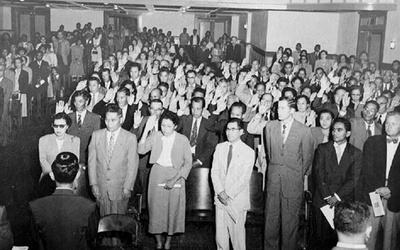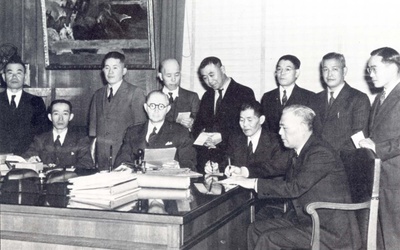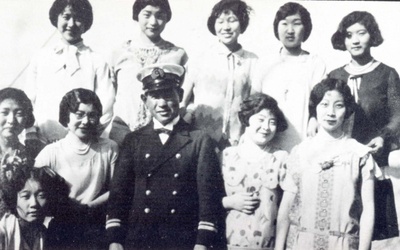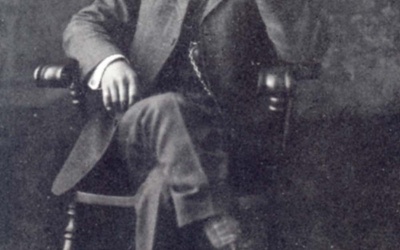In This Great Land of Freedom: The Japanese Pioneers of Oregon

In 1993, the Japanese American National Museum organized In This Great Land of Freedom: The Japanese Pioneers of Oregon, one of its earliest exhibitions. Created by the museum in partnership with the Oregon Historical Society and the Japanese American community in Oregon, the exhibition tells of the early struggles and triumphs of the Japanese pioneers of Oregon from 1890 to 1952. Unfortunately, since the exhibition happened before the rise of common internet usage, online documentation of it is scant, as is online information about Issei history in general.
Discover Nikkei is pleased, therefore, to reprint the entirety of the catalog essay from the exhibition, along with its accompanying photographs. The essay traces the journey of Oregon’s first Japanese immigrants, from their arrival in the 1880s and their early struggles, through the development of Japanese farming communities, the disruptions wrought by the World War II incarceration, and the important postwar legal victories. It will be published here chapter by chapter in an effort, in the words of exhibition project coordinator George Katagiri, “to preserve the story of our parents and grandparents…a story that was fast disappearing.”
You can purchase the exhibition catalog at the Japanese American National Museum Store.
Stories from this series
Chapter 8 — Renewed Oppression and Final Struggle
Dec. 11, 2017 • Eiichiro Azuma
Once he was our friendThe owner of the store nowBehaves nervouslyRefusing to sell us goods Shizue Iwatsuki1 With the war coming to an end, Oregon experienced renewed anti-Japanese movements. In Gresham, local farmers and businessmen, inspired by the economic advantage of Japanese exclusion, started a campaign to prevent their return as early as 1943. This movement led to the establishment of the Oregon Anti-Japanese Inc., in November, 1944. Later renamed the Japanese Exclusion League, this group called for “the enactment …
Chapter 7 — Issei Life Behind Barbed Wire
Dec. 5, 2017 • Eiichiro Azuma
The harsh winds of autumnPierce the spirit of thoseWho live at the mercy of fateCreated by the war. Akiyama1 The internees had primitive living conditions. The North Portland Assembly Center had previously been used as the Pacific International Livestock Exposition Building and was barely adapted for human habitation. Each family was assigned to a small, single room in a large barrack with walls made of thin plywood sheets. In order to make each room as “homey” as possible, the internees …
Chapter 6 — Pearl Harbor: Days of Anguish and Confusion
Nov. 27, 2017 • Eiichiro Azuma
We have spent two-thirds of our lives in the United States and we feel we are more American than Japanese; we are willing to do anything we may be asked to do to help our foster mother. A Portland Issei, January 23, 19421 Japan’s attack on Pearl Harbor had a profound impact on Issei life. Immediately classified as “enemy aliens,” they were no longer able to assure security for themselves or for their children. “Asleep or awake, I felt as …
Chapter 5 — The Struggle Against Exclusion
Nov. 20, 2017 • Eiichiro Azuma
A series of exclusionsNow getting used to itI spend each day farming Honda Fugetsu1 While building their community and industries, Japanese immigrants struggled against exclusionists’ threats. Combined with the rise of anti-foreign sentiments of World War I, the rapid growth of Issei agriculture stirred whites’ fear of Japanese competition. As the Hood River Japanese farmers showed a notable prosperity with a high level of land ownership, they became the prime target of organized exclusionist attacks. The local American Legion was …
Chapter 4 — Japanese Immigrant Families and Community Development
Nov. 13, 2017 • Eiichiro Azuma
“Japan is such a small island country…. What is the use of returning to such a place? If we have to fulfill our filial duty to parents and live with wives, why don’t we have them come to America? If the difference in the language and customs bothers us, why don’t we learn to adapt to them”1 Masuo Yasui The rapid development of Japanese farm communities in Oregon was marked by the emergence of families. The early Japanese immigrant society …
Chapter 3 — Development of Japanese Farming Communities
Nov. 6, 2017 • Eiichiro Azuma
The untouched ground of AmericaI began to hoeThis virgin soil. Honda Fugetsu1 During the 1900s, many Japanese immigrants moved into agricultural work. At first, the Issei were drawn by better wages to work on farms. In 1909, farm laborers represented more than a quarter of the total 3,873 Japanese in Oregon. Known as buranke katsugi [blanket carriers], they were seasonal migrants, carrying blankets with a few other daily necessities. Many of these men subsequently invested their earnings and rose above …








